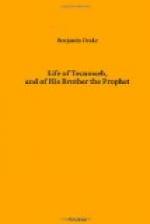In the month of September, the Prophet sent assurances to governor Harrison of his pacific intentions, and that his demands should be complied with; but about the same time some horses were stolen in the neighborhood of his town, and the whites who went in pursuit of them were fired upon by the Indians. Early in October the governor moved, with a considerable body of troops, towards the Prophet’s town, with the expectation that a show of hostile measures would bring about an accommodation with the Indians of that place. On the 10th of October, one of the sentinels around his camp was fired on by the Indians, and severely wounded. About the same time the Prophet sent a messenger to the chiefs of the Delaware tribe, who were friendly to the United States, requiring, them to say whether they would or would not join him in the war against them; that he had taken up the tomahawk and would not lay it down but with his life, unless their wrongs were redressed. The Delaware chiefs immediately visited the Prophet, for the purpose of dissuading him from commencing hostilities. Under these circumstances there seemed to be no alternative for governor Harrison, but to break up the Prophet’s establishment. On the 27th, the Delaware chiefs returned to the camp of the governor, and reported that the Prophet would not listen to their council, and had grossly insulted them. While at the Prophet’s town, the Indians who had wounded the sentinel, returned. They were Shawanoes and near friends of the Prophet; who was daily practising certain pretended rites, by means of which he played upon the superstitious feelings of his followers, and kept them in a state of feverish excitement. On the 29th, a body of twenty-four Miami chiefs were sent by governor Harrison, to make another effort with the Prophet. They were instructed, to require that the Winnebagoes, Potawatamies and Kickapoos, should leave him and return to their respective tribes; that all the stolen horses in their possession should be delivered up; that the murderers of the whites should either be surrendered or satisfactory proof offered that they were not under his control. These chiefs, however, did not return, and there is reason to believe that they were induced to join the confederacy at Tippecanoe.
On the 5th of November, 1811, governor Harrison, with about nine hundred effective troops, composed of two hundred and fifty of the 4th regiment U.S. infantry, one hundred and thirty volunteers, and a body of militia, encamped within ten miles of the Prophet’s town. On the next day, when the army was within five miles of the village, reconnoitering parties of the Indians were seen, but they refused to hold any conversation with the interpreters sent forward by the governor to open a communication with them. When within a mile and a half of the town a halt was made, for the purpose of encamping for the night. Several of the field officers urged the governor to make an immediate assault on the village; but this he declined,




